【完整升级版】新目标七年级英语上册教案1
人教版新目标七年级英语上册教案(全册)

人教版新目标七年级英语上册教案Unit one My name is Gina.教材分析1.话题:Making new friends2.功能目标:1)使学生学会用英语介绍自己。
3.文化目标:1)让学生初步体会用英语和别人交流的感受,培养学生学习英语的兴趣。
2)通过对英文名字的介绍,对比中西方表达名字的不同,了解中西方文化的差异。
3)通过对西方一些成功人士英文名字的介绍,使学生了解成功是由不懈的努力和艰苦的奋斗得来的。
4.认知目标:1)词汇:clock, hello, hi, and, question, answer, look, first name, last name2) 语法项目:一般现在时be的用法以特殊疑问词what开头的问句形容词性物主代词my, your, his, herWhat’s=What is I’m=I am My name’s=My name is3) 语言目标:What’s your name?My name is Gina.I’m Gina. Nice to meet you.Period oneLanguage topic: What’s your name?My name is Gina.Language strategies: Talk about the namesMain vocabulary: name is, meet, his, first name, last name, answer, boy , girl.II.语言结构: present tense to be, what questions, Possessive adj. my, your, his, her. 。
III.语言功能:询问姓名及怎样回答.IV.活动设计:采访调查What’s your first name?V. Teaching steps:Step 1:Greetings.Step 2: Words:Learn the new wordsA: first, listen to the recorder, the students read after the recorder.B: read the new words after the teacher.Step 3: 1a Write English words for the things in the picture. How many things do you know?Step 4: 1b Listen and number the conversations . three times.Step 5: 2a Listen to the four conversations and number the conversations (1--4) Step 6: 2b Listen and circle the names you hear. .Step 7: 3a. read the names. Write the first names and the last names.Step 8: Let’s sum what we have learned this class.Words:Sentences:Something else:Step 9: HomeworkPeriod 2I.教材分析:这是课本的第二部分,活动内容比较多,学生对教材很有兴趣,例如做学生证,用英语填写自己的名字。
七年级新目标英语上册全册教案新人教版

七年级新目标英语上册全册教案新人教版教案内容:第一章:Unit 1 My Name's Gina1.1 教学目标能听懂、会说、会读关于自我介绍的简单句子。
能运用所学介绍自己的姓名、年龄、年级和来自哪里。
能通过情景交际,运用所学句子进行简单的自我介绍。
1.2 教学重点与难点重点:介绍自己的姓名、年龄、年级和来自哪里。
难点:正确运用英语进行自我介绍。
1.3 教学步骤Step 1:热身活动(5分钟)教师与学生进行简单的英语对话,营造轻松的课堂氛围。
Step 2:新课导入(10分钟)教师出示图片,引导学生进行观察,引出本课的主题。
Step 3:课堂活动(15分钟)教师引导学生进行自我介绍,鼓励学生大胆开口说英语。
学生进行小组活动,互相练习介绍自己。
Step 4:巩固练习(10分钟)教师设计听力练习,让学生听懂并回答相关问题。
学生进行口语练习,运用所学句子进行自我介绍。
Step 5:课堂小结(5分钟)第二章:Unit 2 Nice to Meet You2.1 教学目标能听懂、会说、会读关于问候和介绍的简单句子。
能运用所学进行问候和介绍,并能够进行简单的对话。
2.2 教学重点与难点重点:问候和介绍的常用句子。
难点:正确运用所学句子进行对话。
2.3 教学步骤Step 1:热身活动(5分钟)教师与学生进行简单的英语对话,营造轻松的课堂氛围。
Step 2:新课导入(10分钟)教师出示图片,引导学生进行观察,引出本课的主题。
Step 3:课堂活动(15分钟)教师引导学生进行问候和介绍,鼓励学生大胆开口说英语。
学生进行小组活动,互相练习问候和介绍。
Step 4:巩固练习(10分钟)教师设计听力练习,让学生听懂并回答相关问题。
学生进行口语练习,运用所学句子进行对话。
Step 5:课堂小结(5分钟)后续章节待补充。
第六章:Unit 3 My Family6.1 教学目标能听懂、会说、会读关于家庭成员的简单句子。
新目标七年级英语上册教案(全集)

新目标七年级英语上册教案(全集)Starter Unit 1 Good morning!课程目标一、知识和能力目标本单元要求学生掌握英文字母A—H,能认读其印刷体和手写体字母的大小写等四种形式。
书写(大写和小写,笔顺,笔画)基本合乎要求。
能看,听,说本单元所列的日常交际用语,重点学会打招呼,并做到语音语调正确。
注意一些字母及日常交际用语的发音,提醒学生不要将C/si:/发成/sei:/;也不要将Good morning/二、过程和方法目标教师要尽量用英语组织教学。
充分利用课堂的40分钟,不讲或少讲汉语,尽量给学生创造英语情景。
教师可以用手势,表情,动作等示意,帮助学生听懂课堂用语和日常交际用语,第一次介绍某个用语时,说英语,加译文及手势,以后可酌情省去译文,最后只说英语,逐步让学生听懂。
三、情感态度和价值观目标万事开头难,首先利用这个单元培养学生们对英语的兴趣,因为兴趣是最好的老师。
学情分析体会打招呼用语的奥妙所在,做到灵活运用。
1.Good morning /afternoon /evening:适用于比较正式客气的场合,双方都应说Good morning /afternoon /evening!例如:A:Good morning,Miss Zhao.早晨好,赵老师。
B:Good morning,Mr.Wang.早晨好,王校长。
2.Morning:适用于比较熟悉的朋友之间或比较繁忙的情况下。
3.Hello:是最广泛、最简单的打招呼语,显得亲切自然。
例如:A:Hello,Kate.你好,凯特。
B:Hero,Li Lei.你好,李雷。
4.Hi:在现代英语中,Hi比Hello用得更多,显得更随和。
例如:A:Hi,Han Meimei.你好,韩梅梅。
B:Hi,Lucy.你好,露西。
教学准备tape—recorder,multimedium.课时参考四课时Period 1Step 1:IntroductionBegin by greeting the class with a smile and good morning!Now,introduce the words “teacher” and “class”.by using gestures.Repeatthis several times and have the class repeat after you.Students Can answer as a whole group.As rows and as individuals.Repeat “I am your teacher and you are the class” several times.Now,introduce the class to the instructions:Class,please sit down and class,please stand up by using actions and gestures.They can practice this several times.You may want t0 leave the class again to introduce the usual Good morning routine.Say Good morning class.Help students respond with Good morning.Point to yourself and say I’m Miss/,Mr.…Have them repeat.Explain the terms Miss and Mr.in Chinese.Repeat this a few times with rows and individuals or try a “back-chain” drill:Miss,Mr.… (Ss repeat)Morning,Miss/M r.… (S s repeat)Good morning,Miss,Mr.… (Ss repeat)Step 3:PracticeSay:Stand up,please! (Ss stand up)Leave the classroom,return and say Good morning,class! Help the students respond with Good morning,Miss/,Mr.…Say Sit down,please.No w let’s sta rt the lesson.Step 4:Presentation and activityNow point to yourself and say My name is Miss/Mr. … I am your teacher.Find a student you know and say your name is…(Beth).Then ask What is your name? Help them respond with My name is… . When the student answers, respond with Hel lo…Nice to meet you! Repeat this activity several times,first with students you know and then with others.Help them to respond with Nice to meet you,too.Explain the Word “too’’ in Chinese.Step 5:PracticeGet the students to practice the f0llowing dialogue in pairs.S1:Good morning.S2:Good morning.I’m (Ben).What’s your name?Sl:My name is (Dale).Nice to meet you!S2:Nice to meet you.too.Call out several pairs of students to give their performance.Praise their efforts as much as possible.Help the slower students with patience.Step 6:PresentationDo activity 1a:Look at the picture.Find the small letters for these big letters.First present letters a-h,and get the students to repeat these letters.Call the students to attention the letter C /si:/not/sei:/.H /eʧ/ not /eʧ/Step 7:Listening and writingGet the students to listen to the tape and finish the task list on the book.Make sure all the students know what they should do.Have the students watch the teacher writing the letters on the blackboard, then ask them to follow the teacher and write down these letters on their exercise—books.Let the students know the diffences between the big letters and the small letters.Step 8:Games timeLet the students do some letters games to enjoy your lesson,the following is the instruction.抢读字母游戏:教师将全班分成若干小组,然后逐个出示字母卡片,学生们举手抢答。
新目标英语七年级上册教案

新目标英语七年级上册教案一、教学目标1.学习并掌握基本的英语语音、语调和音标;2.学习掌握英语的基本问候语和自我介绍;3.学习并掌握英语的基本日常用语,包括数字、颜色、时间等;4.学习并掌握英语的基本语法结构,包括各类句型的构造和用法;5.培养学生的听、说、读、写的英语综合能力。
二、教学内容1. Unit 1: Hello!•课程目标:学习基本的英语问候语和自我介绍,培养学生的听、说、读、写的能力。
•课堂活动:–观看英语问候语和自我介绍的视频,学习正确发音和语调;–分角色进行问候和自我介绍的对话练习;–独立完成一篇简短的自我介绍,展示给全班同学;–练习听力,听录音完成相关练习题。
2. Unit 2: My Schoolbag•课程目标:学习描述个人物品的基本词汇,学会用英语进行简单的物品描述。
•课堂活动:–掌握物品的英文词汇,包括笔、书、橡皮等;–观看描述物品的图片,学习描述物品的基本句型;–分组游戏,通过描述物品让同伴猜出是何物;–完成一篇有关个人物品的短文,展示给同学。
3. Unit 3: My Hobbies•课程目标:学习描述个人爱好的基本词汇,培养学生用英语进行爱好描述的能力。
•课堂活动:–学习和巩固有关爱好的英语词汇,并学习如何描述自己的爱好;–分组交流自己的爱好,并在小组内制作一张关于爱好的海报;–进行小组展示,与其他小组分享自己的爱好;–完成一篇关于自己爱好的短文,展示给全班。
4. Unit 4: My Home•课程目标:学习描述家庭成员和家庭环境的基本词汇,培养学生描述家庭情况的能力。
•课堂活动:–学习家庭成员和家庭环境的英语词汇;–进行角色扮演,描述自己的家庭成员和家庭环境;–分组合作,用英语编写一段对话,描述各自的家庭情况;–完成一篇关于自己家庭的作文,展示给全班。
三、教学方法1.任务型教学法:通过任务和情境来激发学生学习兴趣,培养学生的英语实际应用能力。
2.合作学习法:通过分组合作,让学生在交流和合作中更好地学习和提高。
七年级英语上册 Unit 1 教案 (新版)人教新目标版

Period 1 Section A 1a1cⅠ.教学准备1.教师:录音机、电脑、图片、面具。
2.学生:利用网络查阅中英文姓名及初次见面时各国或各地风俗、礼仪的材料。
Ⅱ.教学目标1.学会问候他人。
2.学会做自我介绍,认识新朋友,并正确称呼他们的英文名字。
3.学习本课的知识点。
(1)词汇:name,nice,to,meet,too,your,Ms.(2)句型:—What's your name?—My name's...—Hello!Cindy!I'm Dale.—Nice to meet you!what's=what is I'm = I am name's = name isⅢ.教学重点难点1.让学生学会做自我介绍,学会交朋友。
2.正确使用问候语。
Ⅳ.教学步骤Step 1:Greetings and talking运用预备单元学习的Good morning!Good afternoon!Hello/Hi!...等问候语和学生打招呼,拉近了与学生之间的距离,也复习了旧知识。
Step 2:Leadin1.利用一些实物,复习“What's this in English?”这一句型。
For example:T:What's this in English?S:It's a book.T:What color is it?S:It's blue.2.运用以上句型过渡到课本1a,写出图中物品的英文名称。
For example:T:Look at the picture.What's this in English?S:It's a map.T:How many new words can you find?Discuss in groups.将学生分为四组,采取小组竞赛制,每组选择一名学生将单词写在黑板上,比一比哪一组写得多。
新目标英语七年级上Unit1教案:初学者的英语基础
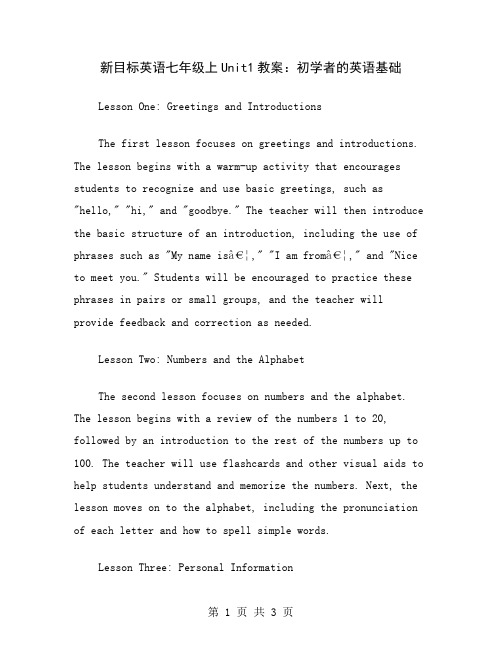
新目标英语七年级上Unit1教案:初学者的英语基础Lesson One: Greetings and IntroductionsThe first lesson focuses on greetings and introductions. The lesson begins with a warm-up activity that encourages students to recognize and use basic greetings, such as "hello," "hi," and "goodbye." The teacher will then introduce the basic structure of an introduction, including the use of phrases such as "My name is…," "I am from…," and "Nice to meet you." Students will be encouraged to practice these phrases in pairs or small groups, and the teacher will provide feedback and correction as needed.Lesson Two: Numbers and the AlphabetThe second lesson focuses on numbers and the alphabet. The lesson begins with a review of the numbers 1 to 20, followed by an introduction to the rest of the numbers up to 100. The teacher will use flashcards and other visual aids to help students understand and memorize the numbers. Next, the lesson moves on to the alphabet, including the pronunciation of each letter and how to spell simple words.Lesson Three: Personal InformationThe third lesson focuses on personal information. Students will learn how to ask and answer basic questions about themselves, such as their name, age, and nationality. The teacher will again use visual aids, such as flashcards, to help students understand and memorize vocabulary. Students will practice asking and answering questions in pairs or small groups, with the teacher providing feedback and correction as needed.Lesson Four: Classroom ObjectsThe fourth lesson focuses on classroom objects. Students will learn the vocabulary for common classroom objects, including desks, chairs, pencils, and paper. The teacher will use visual aids, such as flashcards and real objects, to help students understand and memorize the vocabulary. Studentswill practice using the vocabulary in sentences, with the teacher providing feedback and correction as needed.Lesson Five: Days of the Week and Months of the YearThe fifth lesson focuses on the days of the week and months of the year. Students will learn how to say and spell the days of the week and months of the year. The teacher willuse visual aids, such as a calendar, to help students understand and memorize the vocabulary. Students willpractice using the vocabulary in sentences, with the teacher providing feedback and correction as needed.AssessmentAt the end of Unit 1, students will be assessed on their understanding of the vocabulary and basic grammar structures covered in the unit. The assessment may include a written test, an oral exam, or a combination of both. The assessment will be designed to evaluate students' ability to use the basic English language structures covered in the unit.ConclusionThe New Target English 7A Unit 1 lesson plan is designed to provide a foundational understanding of English basics for beginners. The lessons are structured to help students understand and use basic greetings and introductions, numbers and the alphabet, personal information, classroom objects, and days of the week and months of the year. By the end of Unit 1, students should have a good understanding of basic English vocabulary and grammar structures, which can be built upon in subsequent units.。
初中七年级新目标英语上册全册教案

初中七年级|新目标英语上册全册教案Unit 1 My name ,s Gina第|一课时教案例如教学目标1.学会询问周围新同学的姓名,并且将自己刚认识的好朋友介绍给全体同学2.通过学生制作名卡或桌卡来提高学生学习英语的兴趣,表达英语的实用性3.通过以上任务活动,掌握形容词性物主代词的用法及其与人称代词的主格的区别,并且在第|一节课让学生对英语的学习产生兴趣.4.德育目标:热爱班集体,团结同学.教学重点和难点1.形容词性物主代词的用法2.在任务活动中掌握you和your ,he和his, she和her 的用法3.重点句型(斜体字为扩展句子):Hi / Hello! Good morning / afternoon / evening.How are you? Fine, thank you! / Very well / So -so /All right.What ,s your name? My name is …/ I ,m …What ,s his/ her name? His/Her name is …课前准备1.学生课前准备:利用网络查阅中英文姓名及初次见面时各国或各地风俗,礼仪体会它们的不同之处;准备硬纸片和水彩笔;用英文介绍自己的姓、名.2.教学器材:录音机、电脑、图片.3.教学课件:中英文名字展示片.教学设计Tasks Students , activities Teacher ,s activities1. Game: ask and answer the question: What ,s your name? Students make a self -introduction and pass the sentences one by one. At first, teacher makes a self -introduction.2.Two students act out how to greet people. Act out the greeting forms they are familiar with or they find on net. Show the students the pictures of other countries , customs with computer.3. See who can make the most friends and get the most information. Then report their results with his or hers. Move around to make friends with the ones they are interested in. Make the students move around to make friends with others.4. Design and make their name cards . Design and make their name cards in groups. Ask them to design their name cards and see which group is the best.教学过程设计任务一:结识新朋友 .1.老师首|先向学生做一个自我介绍,将名字写在黑板上: My name is …, My first name is…, My last name is …同时介绍一下名字的意义,然后学生就近结组,进行自我介绍.例如:一个学生叫徐烨,他说:My name is Xu Ye. Ye means light;一个叫|王超的学生介绍说: My name is Wang Chao. Chao means Superman .这个任务能够激起学生学习英语的兴趣,同时扩大词汇量.2."What ,s your name?〞传句子比赛.学生按行分组,一个同学问, "What ,s your name?〞第二个学生答复, "My name is …〞然后再接着问第三个人, "What ,s your name?〞第三个人答, "My name is …His/ her name is …〞再接着问第四个人What ,s your name?〞 . . .看哪个组最|先获胜.任务二:学生利用电脑向大家展示他们所搜集的中英文姓,问候语名及各国或各地初次见面时的礼仪,体会它们的不同之处;然后由抽签决定各组同学分别用哪个国|家或哪个地区的礼仪(例如:日式、美式、法式和学校版的礼仪)来表演两个人初次见面时的问候语及谈话内容(用英文) ,看哪一组同学表演的形象,语言准确,最|后评出最|正确组合.任务三:找朋友.并将他或她参加你的朋友记录中.该任务是通过学生自己去询问他们感兴趣的同学的爱好,找出他们之间的共同点,然后和他们交朋友(利用时间争取和所有的同学交朋友,了解他们各自的优点) ,并将自己所掌握的新朋友的信息介绍给全体同学,让大家了解他(们) .在该任务的执行过程当中,学生可以尽量施展他们的才能,倾尽其所学的英文知识来展示自己并且看谁能获得最|多的信息.因此,这项任务在调动学生学习英语兴趣的同时,也反复操练了本单元的关键句型和形容词性物主代词,尤其是he and his, she and her;同时运用到一些超出本课教学内容的语言知识,学生参与性强,最|大限度的调动了他们的积极性,同时也为学生树立了英语学习的信心.Name Hobbies Other information任务四:制作姓名卡.制作姓名卡,由小组协作共同完成名卡的设计与制作,名卡中要求包括学生的汉语名字(拼音书写)和英文名字,其他的内容由各组自行设计,但要求每个人的名卡的设计要有创意、表达小组的共性、美观大方、经久耐用、语言准确.因此,该任务既表达个性,又表达共性;既有分工,又有合作.任务五:作业.为自己、父母、亲朋好友找一个有意义的英文名字,同时将他们介绍给你的同学们.教学点评本节课的设计表达了任务型教学的特点,同时整个任务链的设计均以学生的兴趣为主,由易至|难,逐层递进,逐步完成各个任务,使学生在愉快的完成每一个任务的同时,体会到学习英语的乐趣,并使每一位学生都参与到活动中,都有所提高.本节课由于是新学期的第|一节课,在教学中,本着"新学期、新起点、新观念、新认识〞的观点设计了四个快乐的任务,同时这几个任务相互连接,环环相扣,形成了一个完整的任务链.整节课课堂气氛活泼,学生学习英语的兴趣始终很浓.尤其是"找朋友〞这个任务,极大地调动了学生的积极性,学生们说出了很多精彩的句子, .而在制作名卡时,各小组通力合作,气氛和谐,作品各具特色,表达了任务型教学中共同合作与个性张扬的优势.在解释自己名字的任务中,充分调动了学生的表现欲,学生们的名言经整理后被保存下来,提高了学生学习英语的积极性.在各国礼仪表演中学生既学到了英文知识,又了解了其他各国各地的风俗,将知识"延伸到课堂之外的学习和生活之中〞.因此,这节课中的活动具有可操作性,并以学生的生活经验和兴趣出发,使学生的思维和想象力、审美情趣得到开展,从而提高学生实际语言运用能力.另外,本节课的德育目标,使英语教学与其他学科结合起来.当然本节课中也存在几个需要继续探索的问题:一、师生均是初次接触任务型教学,对其仅是好奇及尝试,尚未能领会其主旨.二、活动中课堂秩序稍有些乱,在以后课堂中应加以指导.教师本身也需要提高对新课标和任务型教学的认识,以完善今后的教学.第二课时教案例如教学目标1.介绍更多的英文姓名,并且区分出姓和名;2.学习英语中姓名(name/ full name )、姓(family name/last name )和名(given name/first name )的用法;3.通过用英语说出自己的号码的任务,学习数字0 -9;4.制作身份证,以综合运用所学的姓名和数字;5.德育目标:我长大了,学会对人有礼貌、学会感谢.教学重点和难点1.了解英语与汉语中姓与名的位置不同,准确掌握英语的姓与名的表达;2、听懂并能说出号码,培养学生的英语意识.3.重点句型:What ,s your English name?My English name is …What ,s your last name/ family name?My last / family name is …What ,s your telephone number?My telephone number is …主题词(斜体字为扩展词):last name family namesecond name surname Tanaka Barnes Green Mitchell Jones Lim Smith Brown Cooper Lockefirst namegiven name Tony Bill Paul Mark Amy Gina Kenji Lisa Chi -yong Mary Kate Katherine Elizabeth Kim Mike Nick Tom Johntelephone number课前准备1.学生课前准备:父母或朋友的录音磁带、硬纸卡片2.教学器材:、小皮球、录音机、电脑3.教学课件:身份证课件教学设计Tasks Students , activities Teacher ,s activities1. Game: throw the ball while asking and answering the question. In groups, one student throws the ball and asks: "What ,s your English name?〞, the other one answers it ,then throw the ball again. Do this game first as an example.2. Guess, "Who is he/ she?〞Play students , tape and ask the other students to guess who the speaker is. Introduce two words: family name and first name.3.Create the Class Telephone Book Interview other students what are their telephone numbers. Direct.4.Check the telephone number from 114. One student is the operator, others can check the telephone number by asking : "What ,s ×××,s telephone number?〞Ask the students to do it ,and tell them the rules.5.Make ID Card. They can add some information as a real ID Card. Then, make their own ID Card in groups. Show students the teacher ,s ID Card on the computer.教学过程设计一、接力游戏询问学生的英文名.首|先由教师仿做,教师拿出一个小皮球,任意抛向一名学生,同时问:"What ,s your English name ?〞,这个学生接住球并答复:"My English name is …〞, 然后由这名学生将球抛向另一名学生, 第二名学生在接物品时必须答复:"My English name is …,his/her English name is …(只要重复前一名学生的名字即可)〞,然后传递下去并问:"What ,s your English name ?〞.最|后将学生分为几组在组内做.在这个活动中,学生的积极性很高(球必须接住,否那么也算做失误) ,到达<课标>中要求的既从学生的兴趣出发,又具备易操作的特点.二、做"新学期的新祝愿〞.在这个活动中,同时引入姓(family name/last name )和名(given name/first name )与汉语的位置区别.将学生所录制的带有家人或朋友的祝福的磁带放在录音机中,同时用英语介绍:" His/Her family name is …, his/her first name is …,do you know who is he/she ? 〞然后由其他学生猜:"This is your father ,his name is …〞 .在猜的过程中,学生可以加上他们会的其他的信息,例如:他(她)的职业等,充分展示他们的所长并为猜的学生提供一些提示性信息,三次时机,猜对了加分.在这个任务活动操作过程中,给了学生很大空间去发挥,也用到了一些本单元未涉及到的句型,例如:What ,s he/she? Is he/she in our class? How old is he/she? 等 .三、建立班级| 簿.学生互相询问号码,用"What ,s your telephone number?〞这个句型,并记录在教师发的记录卡上,最|后经过整理,再加上一些公益,形成班级| 簿.附表:Name Family name First name Telephone number四、这个任务是模仿114查号台,该任务利用上一个任务整理后的班级| 簿去查询,它要求每一位学生都要投入角色,尤其是作为话务员,要求声音甜美、温和,态度和蔼.其实施过程是由一个学生作为话务员,其他学生可以任意拨通并且询问:"What ,s ×××,s telephone number?〞,同时话务员答复:" His/Her telephone number is …〞.这项任务的设计主要是为了在任务活动中练习让学生脱口而出0 -9这几个英文数字,同时,这项任务活动的过程中所用到的句型What ,s ×××,s telephone number ?和His/Her telephone number is …中,His和Her 是对上一节课形容词性物主代词的一个复习,而" ×××,s telephone number〞对于本单元在内容上是一个补充和提高.五、制作ID Card .首|先用电脑展示教师本人的真实身份证的样本,同时告诉学生我们的家长及朋友对我们的祝福都是希望我们在新的一年里像一个大人了,那我们就要为自己制作我们的身份证来证明我们长大了,我们会努力做到最|好.然后,观察老师的身份证,有哪些需要更改的,提出更好的建议,制作学生心中理想的身份证.以下是学生修改后的身份证:附表:ID CardName:Gender:PhotoAge:Class:School:Address:Postcode:Tele Number:E -mail:ID Card No.:20020500102六、本节课的作业设计是延续身份证的制作,要求学生写一个"自我介绍〞将本节课所学的知识得以提升,字数不限,我认为这个活动既可以检验学生这两节课所学到的知识,同时又可以对整体学生的水平有一个了解,应该是一项具有延伸性和拓展性的作业.教学点评本节任务型课程的设计比起第|一节课的内容,有一定难度,知识量、信息量都增加了.例如:英语和汉语中姓与名的区分就是一个难点,在以后的课程中仍需要进一步加以区分 .整个任务链的设计仍然以任务教学为主要的依据,同时遵循教学的规律,各个任务以学生的兴趣为出发点,高潮迭起,做到"乐而学,学而乐〞.本节课设计的第|一个游戏在整个这节课起到了调动学生兴趣的作用,学生参与性高,为以下的任务活动及本节课的进展起到了"开门红〞的作用.在"新学期的新祝福〞这一任务中,当他们的父母、亲朋或好友的祝福声音传出来的时候,每一位学生的脸上都漾着喜悦的微笑,在做介绍时,很自豪的说:"这是我的爸爸,这是我的妈妈!〞.这个任务在设计时,按照<课标>中要求的与其他各学科相结合,融会贯穿,我希望学生在新的学期拥有美好的愿望,同时加上朋友的真诚的祝福会对他们的学习助以一臂之力,而当这个任务完成时,我感到我的初衷到达了.另一个任务做114 台查询,是另一个高潮.学生当中有很多人拨打过这个号码,因此,对这项业务相当熟悉,学得惟妙惟肖,做到了"活动要以学生的生活经验和兴趣为出发点,内容和方式要尽量真实;活动要有利于学生学习英语知识,开展语言技能,从而提高学生实际语言运用能力〞.最|后制作身份证的活动,学生将所学知识与实际生活相结合,积极发散思维,制作适合他们并且证明他们是一个成人的证件,这一点符合学生到初中之后希望他们周围的人能够用成人的眼光来看待自己.同时,本节课的作业是一项具有延伸性和拓展性的作业,也是写作的一次尝试.总之,这节课的任务设计我认为还是比拟成功的,根本到达预先的想法.但是,它也存在以下几个需要继续探讨的问题:第|一、在建立班级| 簿的任务中显得时间较为仓促,调整本课时间安排.第二、在制作身份证的过程中,个别学生的动手能力稍差,导致任务未完成,需考虑小组互助.Unit 2 Is this your pencil?第|一课时教案例如教学目标能够掌握常见物品的英文表达能够询问教室物品或文具名称并找到物主能够综合运用所学句型汇|报活动结果教学向导语言目标学习策略与思维技巧重点词汇运用this /that 的一般疑问句及其答句;What 引导的特殊疑问句及其简略答复. 以游戏的形式,做出推理与判断,培养综合分析能力. pencil, pen, book, eraser, pencil -case, backpack, ruler, key,ID card, baseball, watch, game, ring, computer, notebook语言结构语言功能跨学科学习Demonstratives this, that;What questions;Yes/No questions and short answersHow do you spell pencil?(Formulaic) 寻找物主培养学生绘画和写作能力主题词表pencil, pen, book, eraser, pencil -case, backpack, ruler, key, ID card, baseball, watch, game, ring, computer, notebookExtensive words:textbook; exercise -book; ball -pen; compass; sharpener; rubber; glue; color -pen; sticker; highlight; ball -point; scissors; chalk; file; blackboard; ink; set - square; paper; pamphlet; peg.重点句型(1 )Is this your pencil? Yes, it is./No, it isn ,t.(2 )Is that my book? Yes, it is./ No, it isn ,t.(3 )Is this/that her/his eraser? Yes, it is./ No, it isn ,t.(4 ) What ,s this/ that in English? It ,s a/an ……(5 )How do you spell pen? P -E -N.主题思维图及任务型活动课前准备让学生收集并自学有关文具或教室物品的名词,并准备一些实物或图片.教师事先应对学生常用的文具有所了解,同时收集局部同学的物品,对于不能出示实物的用具那么应准备一些简图.让学生挑选一件自己喜欢的物品或图片并为该它制作一个英文标签,即写出该物品的英文名称;教师也可根据将学生学习新词时感觉困难的词语,制作自己的标签,将其放入学生的物品中;同时为各小组准备好活动用的纸盒或袋子.Task One: Lead in - - -Learning words.教学目的:学习有关文具的英文表达方式需要学习和掌握的新单词与新句型:pencil, pen, book, eraser, pencil -case, backpack, ruler, key, ID card, baseball, watch, game, ring, computer, notebook1.Is this your pencil? Yes, it is./No, it isn ,t.2.Is that my book? Yes, it is./ No, it isn ,t.3.Is this/that her/his eraser? Yes, it is./ No, it isn ,t.,s this/ that in English? It ,s a/an ……5.How do you spell pen? P -E -N.Step 1: 出示实物或图片,问学生What ,s this/ that in English?导入Task One中新词. (pencil, pen, book, eraser, pencil -case, backpack, ruler, key, ID card,baseball, watch, game, ring, computer, notebook )板书目标词汇.Step 2: 抽取学生中的文具由学生问,学生答;复习上一步所学单词.Step 3: 从学生中收取一局部文具,引入句型Is this your pencil? Yes, it is./No, it isn ,t.或Is that my book? Yes, it is./ No, it isn ,t. etc.Task Two: Guessing game( Finding the owners)教学目的:稳固目标词汇和Is this your pencil?Yes, it is./No, it isn ,t. etc.复习What ,s this/ that in English? It ,s a/an ……How do you spell pen? P -E -N.Step 1: 每位学生将自己准备好的物品放进一个袋子里.Step 2: 教师与一位学生做示范.为接下来的Group work 作铺垫.需要用到的句型打在屏幕上.Step 3: 学生开始做Group work .Step 4: 展示各小组统计的结果,看哪组同学在规定时间内猜出的物品的主人最|多.Task Three: Competition.教学目的:培养学生在一定语境下综合运用目标语的能力.Step 1: 在小组内部将各自的文具聚集到一处.运用句型:This is my …….Step 2: 交换小组成员.来自外组的同学负责寻找相关文具的主人.运用句型:Is this your…..? Is this Jane ,s ……?Step 3: 完成下表并由Group Leader 进行汇|报.stationeryOwner sharpener Pencilcase eraser dictionaryHomework:Write down a dialogue using the words and the target languages.Preview the content of the next period.Blackboard writingUnit 2 Is this your pencil?What ,s this /that in English? It ,s a/an……How do you spell….?Is this your/Tina ,s backpack?Yes, it is. / No, it isn ,t. It ,s his/Mary ,s.教学点评:本课时以寻找物主为主线,用实物或实物简图为学生提供尽可能真实的场景,让学生产生一定的体验,并在体验中学习、探究,课堂气氛活泼,学生学习兴趣高,学习效果也较好.同时教师为学生设计了一个任务链,加强了活动之间的联系,同时活动之间的层次清楚,学生易于接受.本堂课成功的关键是教师课前准备到位,每一个环节都使学生感到新鲜、好奇,在这样一种心理因素的驱使下,学生乐学、好学,教学效果倍增.第二课时教案例如Section ThreeTask Three Draw their own family treeTeaching aims 1. Use the language in the true life.2. Learn to write the language structures.Import and difficult points How to use language in their lifeTeaching methods Listening and speaking; discussing and guessingTeaching apparatuses Tape recorder, pictures, cards, some pictures and photos.Teaching ProcessionDesigns for the class Teacher ,s activities Students , activitiesRevision Is this your father?Is that your mother? Yes, it is.No, it isn ,t.Leading Are they your parents? Yes, they are.Presentation Ask students to present their family treeAdd the words in the box to the family tree.Play the tape.Ask students to read the letter in 3a and then help them to write a letter to EmmaPair work Draw a picture of their family and friends Tell your partner about your picture Ask them to show their letters and correct their mistakes.Help Ss finish 3b. Present their family tree in the group, and then in the class Use the language:This is my father. His name is…This is my mother. Her name is…Finish Ex 1 . Add the words in the box to the family tree.Ask students to listen again , and choose which pictures are Dace and Lin Hai talking about? Read the letter. Draw a picture of Emma ,s family. And then write a letter to EmmaRead their letter to the class.Draw a picture of their family and friends Tell their partner about their pictureTake out their family photo. Write an introduction about the people on the back of the photo.Homework Make their photo Album with some simple introduction.教案点评:整节课设计思路清晰,符合学生的认知能力和认知规律.导入自然,任务衔接较好,给学生一个真实的大任务,以小组为单位,在完成一系列的小任务的同时,完成大任务,在完成任务的同时学会语言.课堂教学形式多样,且以学生活动为主体;能关注学生的情感,整个过程以鼓励评价为主,以评价促学生开展.由于新教材试教时间很短,对任务型教学研究还很不够,学生在做汇|报的时候,如何让全体学生用心去听,是一个急需重视的问题.Unit 3 This is my sister第|一课时教案例如Title Unit 3 This is my sisterTeaching aims Targetlanguages This is my sister.That is my brother.This is Harry's brothersThose are Anne's parentsIs this Harry ,s cousin?Are these his brothers?Skills Talk about the family membersIntroduce the family members to othersEmotions & cultures To know the usual way to get to know each other.To develop the student ,s ability to communicate and cooperate with others.Learning strategies Using what you know, deducing, personalizingKey words Father, mother, parents, grandmother, grandfather, grandparents, aunt, uncle, cousin Important & Difficult Points To know the differences between this and that, these and thoseTo grasp the way of introducing family membersTo get the information from the third personTaskdesignation Task 2Teacher -students wedding party taking photosStudents , Activities Sentence patterns Communication goalIntroduce themselves This is… Introduce yourself and the other peopleIntroduce the members of another group That is…Pairwork: intr oduce the members of their own group and some other group members These are…Those are…Step 2 Family MembersA. Brainstorm. Listen to a clip of the tape. Give me the words and phrases according to the tape. Eg. Who are they? What are they doing?B. Check the answer and listen to the tape again. Complete the simple family tree.Step 3 Wedding partyTask 2Activities Words and sentence patterns Communication goalGuessing game: what is happening on Anne Parents, grandparents uncle, aunt, cousin Introduce the family member to the other peopleIntroduce the family tree This is Harry ,s cousin.These are Harry ,s parents.Group work:Introduce the family members to other peopleCompetition:Compete with other groupsStep 4 Talking about photosActivities Sentence patterns Communication goalDraw the photos Is this Harry ,s mother?Yes, it is. Get information from the third person.Pairwork: Introduce the photos to the partners. This is…That is…These are…Those are…Groupwork: Ask some questions about the photos Are these Harry ,s parents?No, they aren ,t.These are Anne ,s parents.Step 5 SummaryList all the sentence patterns so that all the students know the target languages.教案点评:一.环节设计思路:首|先由学生熟悉的称谓引入,将上节课的单词进行系统复习,为任务的完成做铺垫.小组活动为个人的汇|报作一个统计,由小组长主持,主要目的之一是促进学生之间的互相学习和合作,学会去倾听和区分,学会在集体中发表自己的意见;目的之二,学会关心别人,正确表达自己的喜好二.课后反思:学生是活动的主体,课堂上大局部的时间交给学生,教师的引导是关键.如何一层层的导入,由易至|难的阶梯状任务何时引入,如何引入都是关键所在.同时要注意的是,学生活动之前的范例一定要明确清晰,要每个孩子都知道做什么和怎么做,活动才会顺利的开展,学生才能在活动中有所得 .在课堂设计上表达了任务型教学的主导思想,以任务贯穿教师教学和学生活动的各个环节.学生活动的目的明确,每个步骤教师都给出了活动所需的语言知识内容,学生亦能准确的使用目标语言,在活动中学习掌握知识.第二课时教案例如Section ThreeTask Three Draw their own family treeTeaching aims 1. Use the language in the true life.2. Learn to write the language structures.Import and difficult points How to use language in their lifeTeaching methods Listening and speaking; discussing and guessingTeaching apparatuses Tape recorder, pictures, cards, some pictures and photos.Teaching ProcessionDesigns for the class Teacher ,s activities Students , activitiesRevision Is this your father?Is that your mother? Yes, it is.No, it isn ,t.Leading Are they your parents? Yes, they are.Presentation Ask students to present their family treeAdd the words in the box to the family tree.Play the tape.Ask students to read the letter in 3a and then help them to write a letter to EmmaPair work Draw a picture of their family and friends Tell your partner about your pictureAsk them to show their letters and correct their mistakes.Help Ss finish 3b. Present their family tree in the group, and then in the classUse the language:This is my father. His name is…This is my mother. Her name is…Finish Ex 1 . Add the words in the box to the family tree.Ask students to listen again , and choose which pictures are Dace and Lin Hai talking about? Read the letter. Draw a picture of Emma ,s family. And then write a letter to EmmaRead their letter to the class.Draw a picture of their family and friends Tell their partner about their pictureTake out their family photo. Write an introduction about the people on the back of the photo.Homework Make their photo Album with some simple introduction.教案点评:整节课设计思路清晰,符合学生的认知能力和认知规律.导入自然,任务衔接较好,给学生一个真实的大任务,以小组为单位,在完成一系列的小任务的同时,完成大任务,在完成任务的同时学会语言.课堂教学形式多样,且以学生活动为主体;能关注学生的情感,整个过程以鼓励评价为主,以评价促学生开展.由于新教材试教时间很短,对任务型教学研究还很不够,学生在做汇|报的时候,如何让全体学生用心去听,是一个急需重视的问题.Unit 4 Where ,s my backpackPeriod 1教案例如教学目标掌握关于房间和房间中各种物品的名称学会用使用功能句表述事物的具体位置教学重点Furniture: table, bed, dresser, bookcase, sofa, drawer, chair, desk Proposition: under, on, behind, next to, betweenDaily appliance: alarm clock, CD, video cassette, television1) Where is the baseball?It ,s in the backpack.2) Where is my computer game?It ,s under the bed.3) Where are your books?They ,re on the chair.Step 1 游戏A )请同学根据老师的指令变换自己的位置.如老师说,You are next to the front door now.所有的学生将跟着老师的思路开始进入本单元的主题.B )让学生回忆在刚刚的游戏中,我们到底使用了哪些关于方位的介词,并再一次明确这些方位介词的具体意思和用法.A.要求学生根据事物的真实位置使用一些方位介词表示出事物的准确位置.B.给学生一些例句,引导他们总结出方位介词通常情况下在句中的位置.Step 2 描述我们的教室A ) 同学们通过观察,告诉大家教室里分别有哪些事物,如黑板、电视、书、文具、图片等.B ) 分别说出他们在教室中的具体位置.将两人分为一组,或将四人归为一组,相互寻味对方物品的摆放位置.可以给学生规定出一些事物,就教室中事物的位置进行对话,也可进行讨论.以便学生能够熟练掌握根底的方位表述方式.C ) 课堂练习,连词成句.TV under dresserAir conditioner behind TableBooks Next to SofaVideo cassette on chairStep 3 听录音磁带,并在图中标出他们正确的位置做P20 2A ,2BStep 4 向你的同学介绍宿舍的情况.近来我们学校将要接待一批来自盲人学校的同学来我校学习.为了方便他们的生活和学习,我们将要安排一些同学向他们介绍学校的具体情况,特别是宿舍中一些常用物品的摆放位置以方便他们使用.课前准备:了解学生公寓中生活用品的位置摆放.课堂活动:学生就日常用品的摆放位置进行一一回忆,找到准确位置.。
2020年新目标英语(GOFORIT)七年级上UNIT1教案

新目标英语(Goforit)七年级上Unit1教案新目标英语(Go for it)七年级上Unit 1教案 Unit 1 My name’s Gina Period One 课前准备教师:准备游戏时所用的图片(食物、蔬菜、动物)。
学生:准备表演时所需道具(服装、假发)。
教学设计 Step One :Present the sentence patterns. 1. Play a game “How many words do you know?”(利用小游戏调动学生的积极性,同时通过对冠军的介绍引出本课。
) Teacher: After the study of the first three starters, I think most of the students must have known a lot of words. How many words do you know? Let’s play a game to see who know? Let’s play a game to see who knows the most. (Divide all the students into several groups and show a picture(图片略) to them with the puter. Every group can choose two students to join. They are asked to e to the blackboard and write down the words in 30 seconds.) (Group 2 is the champion group. They can write 11 words.) 2. Introduce the champion group to the class.(引课方式贴近生活,学生易于接受) Teacher: Congratulations, now Group 2 is the champion. But I don’t know your names. Would you like to introduce yourselves to us? S1& S2:Yes. S1:Hello.My name is Li Lei. Nice to meet you. Ss: Hello, Li Lei. Nice to meet you ,too. Ss: Hello! What’s your name? S2:I’m Sun Ping. How do you do? Ss: How do you do ? Step Two: Drills. 1. Make introductions.(通过句型的操练使学生更加熟练掌握所学的句式。
新课标七年级上册英语教案全册(最新7篇)
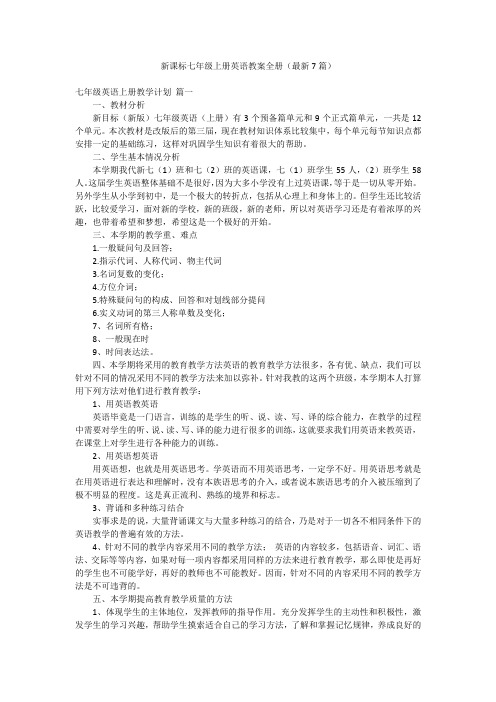
新课标七年级上册英语教案全册(最新7篇)七年级英语上册教学计划篇一一、教材分析新目标(新版)七年级英语(上册)有3个预备篇单元和9个正式篇单元,一共是12个单元。
本次教材是改版后的第三届,现在教材知识体系比较集中,每个单元每节知识点都安排一定的基础练习,这样对巩固学生知识有着很大的帮助。
二、学生基本情况分析本学期我代新七(1)班和七(2)班的英语课,七(1)班学生55人,(2)班学生58人。
这届学生英语整体基础不是很好,因为大多小学没有上过英语课,等于是一切从零开始。
另外学生从小学到初中,是一个极大的转折点,包括从心理上和身体上的。
但学生还比较活跃,比较爱学习,面对新的学校,新的班级,新的老师,所以对英语学习还是有着浓厚的兴趣,也带着希望和梦想,希望这是一个极好的开始。
三、本学期的教学重、难点1.一般疑问句及回答;2.指示代词、人称代词、物主代词3.名词复数的变化;4.方位介词;5.特殊疑问句的构成、回答和对划线部分提问6.实义动词的第三人称单数及变化;7、名词所有格;8、一般现在时9、时间表达法。
四、本学期将采用的教育教学方法英语的教育教学方法很多,各有优、缺点,我们可以针对不同的情况采用不同的教学方法来加以弥补。
针对我教的这两个班级,本学期本人打算用下列方法对他们进行教育教学:1、用英语教英语英语毕竟是一门语言,训练的是学生的听、说、读、写、译的综合能力,在教学的过程中需要对学生的听、说、读、写、译的能力进行很多的训练,这就要求我们用英语来教英语,在课堂上对学生进行各种能力的训练。
2、用英语想英语用英语想,也就是用英语思考。
学英语而不用英语思考,一定学不好。
用英语思考就是在用英语进行表达和理解时,没有本族语思考的介入,或者说本族语思考的介入被压缩到了极不明显的程度。
这是真正流利、熟练的境界和标志。
3、背诵和多种练习结合实事求是的说,大量背诵课文与大量多种练习的结合,乃是对于一切各不相同条件下的英语教学的普遍有效的方法。
新目标七年级上Unit1 教案

新目标七年级上Unit1 教案一、教学目标1.掌握英文数字1-10的读音,并能够正确朗读和书写。
2.学会询问和回答他人年龄并介绍自己的年龄。
3.能够正确使用句型“What’s your name?”和“How old are you?”进行日常交流。
4.了解并学会使用句型“I’m [age] years old.”和“My name is [name].”进行个人简介。
5.学会用英语向他人问好并作出回应。
二、教学重点1.英文数字1-10的读音及书写。
2.询问和回答他人年龄。
3.个人简介的表达。
4.问候和回应。
三、教学准备1.教材《新目标七年级上Unit1》。
2.课件。
3.黑板、白板和彩色粉笔。
4.学生的课本、练习册和笔。
四、教学过程1. Warm-up(热身)•让学生围成一个圈,进行问候和回应的游戏。
–教师会说出一种问候语,例如“Hello!”。
–每个学生依次回答该问候语,并向旁边的同学问好。
–重复以上步骤,每个学生都要说一个问候语。
2. Presentation(呈现)•引导学生注意教材第一单元的标题“Unit 1 My name’s Gina.”•教师出示数字卡片1-10,依次读出并让学生跟读。
•将数字卡片粘贴在黑板上,并让学生用笔记下每个数字对应的英文单词。
3. Practice(练习)•与学生一起进行英文数字的模仿练习,教师读出一个数字,学生模仿声音和口型。
•学生之间互相练习询问和回答年龄的对话,使用句型“What’s your name?”和“How old are you?”。
–教师示范一对一的对话,例如:•Student A: What’s your name?•Student B: My name is Tom.•Student A: How old are you, Tom?•Student B: I’m 12 years old.–学生们进行小组练习,每个学生都要有机会扮演不同的角色。
新目标七年级上英语教案【三篇】
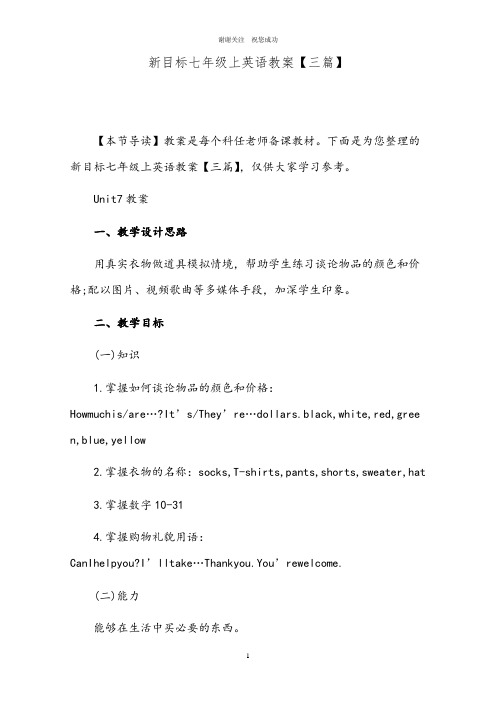
新目标七年级上英语教案【三篇】【本节导读】教案是每个科任老师备课教材。
下面是为您整理的新目标七年级上英语教案【三篇】,仅供大家学习参考。
Unit7教案一、教学设计思路用真实衣物做道具模拟情境,帮助学生练习谈论物品的颜色和价格;配以图片、视频歌曲等多媒体手段,加深学生印象。
二、教学目标(一)知识1.掌握如何谈论物品的颜色和价格:Howmuchis/are…?It’s/They’re…dollars.black,white,red,gree n,blue,yellow2.掌握衣物的名称:socks,T-shirts,pants,shorts,sweater,hat3.掌握数字10-314.掌握购物礼貌用语:CanIhelpyou?I’lltake…Thankyou.You’rewelcome.(二)能力能够在生活中买必要的东西。
(三)情感在生活中要应用礼貌用语。
三、教学重点谈论价钱四、教学难点结合物品的颜色、数量等询问和回答价钱。
五、教学媒体常见衣物;电脑;投影仪六、教学过程(一)巧妙导入方法1:通过询问学生衣服的颜色复习颜色词汇,进而引出衣物的话题。
方法2:拿出不同种类的衣物引起学生注意,进入话题Unit8教案一、教学设计思路结合学生生活设计教学活动,帮助学生掌握日期和生日表达法;利用视频歌曲等辅助教学,提起学生兴趣,加深学生印象。
二、教学目标(一)知识1.掌握日期表达法(月份、日期、序数词):monthsoftheyear,ordinalnumber1st-31st2.掌握生日的相关表达法:Whenisyour/his/herbirthday?My/His/Herbirthdayis…(二)能力能够通过网络等手段查找名人生日等相关资料。
(三)情感学会合理地安排自己的时间,做时间的主人。
三、教学重点日期表达法:monthsoftheyear,ordinalnumber1st-31st四、教学难点日期表达法:monthsoftheyear,ordinalnumber1st-31st五、教学媒体日历或挂历,电脑,投影仪六、教学过程(一)巧妙导入拿出日历或挂历展示,引入月份的话题。
新目标英语七年级上册新目标七年级英语上册starter全英教案
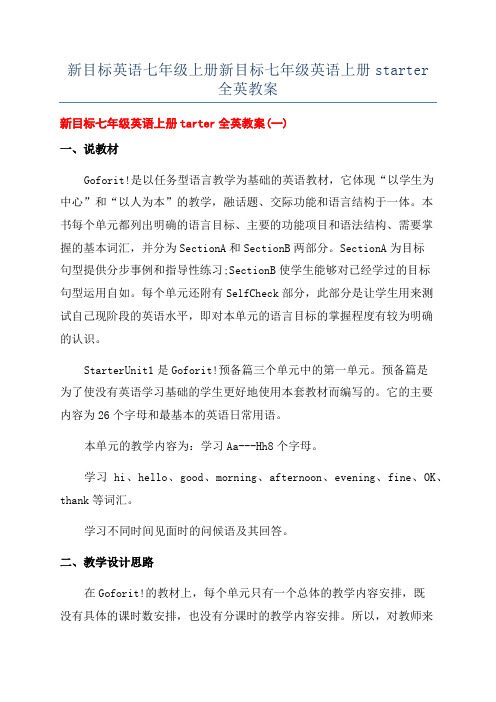
新目标英语七年级上册新目标七年级英语上册starter全英教案新目标七年级英语上册tarter全英教案(一)一、说教材Goforit!是以任务型语言教学为基础的英语教材,它体现“以学生为中心”和“以人为本”的教学,融话题、交际功能和语言结构于一体。
本书每个单元都列出明确的语言目标、主要的功能项目和语法结构、需要掌握的基本词汇,并分为SectionA和SectionB两部分。
SectionA为目标句型提供分步事例和指导性练习;SectionB使学生能够对已经学过的目标句型运用自如。
每个单元还附有SelfCheck部分,此部分是让学生用来测试自己现阶段的英语水平,即对本单元的语言目标的掌握程度有较为明确的认识。
StarterUnit1是Goforit!预备篇三个单元中的第一单元。
预备篇是为了使没有英语学习基础的学生更好地使用本套教材而编写的。
它的主要内容为26个字母和最基本的英语日常用语。
本单元的教学内容为:学习Aa---Hh8个字母。
学习hi、hello、good、morning、afternoon、evening、fine、OK、thank等词汇。
学习不同时间见面时的问候语及其回答。
二、教学设计思路在Goforit!的教材上,每个单元只有一个总体的教学内容安排,既没有具体的课时数安排,也没有分课时的教学内容安排。
所以,对教师来说,这是一个灵活运用教材的机会,任何教学内容的调整和取舍,都是合理的。
但这也是挑战,教师必须从所教学生的实际水平和语言能力出发,合理安排本单元的课时数,设计好每课时的教学内容。
所以,教师在教学设计时,首先因根据自己学生的实际水平和语言能力,排出整个单元的总课时数,然后安排好每个分课时的教学内容,设计好相应的教学步骤,以及运用相应的教学策略。
StarterUnit1的教学重点:Aa----Hh的字母教学相互问候:Goodmorning/afternoon/evening,Alice!Hello,Frank!Hi,Cindy!HowareyouI’mfine/OK,thank.教学难点:a)不同时间的不同问候;b)人名的读法和人物与名字的配对(8个)。
七年级英语新目标上教学设计(成套)

Unit 1 My name’s Gina.单元整体说明单元教材分析本单元继续围绕“结交新朋友”使学生学会打招呼和介绍自己、询问他人姓名的基本句型:“What’s your/his/her name?My/His/Her name is …”; 通过学习区分"First/last name”了解有关姓名的文化知识;通过查询电话号码“What’s your/her/his phone number?”,学习数字1~9,同时也进一步促进学生之间的相互了解;通过以上几个方面的学习,使学生在轻松、愉快的学习氛围中熟识新伙伴。
本单元与第二单元衔接紧密:由课堂内的打招呼、自我介绍到课外、校外相互了解。
由特殊疑问句的学习到一般疑问句的学习,使学生将书本知识运用到实际生活中。
单元知识系统(树)What’s your/his/her name?--- My/His/Her name is ….What’s your/her/his phone number?--- It’s 5352375First /Family /Last name my/ your/her/his单元总体目标运用Practicing, Listening for specific information的学习策略,引导学生学会打招呼和介绍自己、询问他人姓名、查询电话号码的基本句型;了解有关姓名的文化知识;学习特殊疑问句及my/ your/her/his等物主代词的用法。
单元教学重难点一览单元学情分析本单元的主题是熟识新伙伴,同时引导学生采用Practicing, Listening for specific information和Role playing的学习策略,学习一些新词汇,掌握一些重点句型,在小组合作学习的过程中,进一步促进学生之间的相互了解。
单元教学建议采用Practicing, Listening for specific information和Role playing的学习策略,利用教学图片或制作多媒体课件来展开课堂Pair work, Group work的口语交际活动,询问他人姓名、查询电话号码,了解有关姓名的文化知识。
新目标七年级英语上册教案

新目标七年级英语上册教案新目标七班级英语上册教案篇1一、指导思路七班级上学期是小升初过渡的关键时期,是英语学习的起始阶段,所以做好教学方案非常重要。
作为老师应当加强课堂教学,高效地完成本学科教学目标。
乐观参与教科研活动,努力使教学水平、业务本领有更大的提高。
同时,经过传授与同学生活亲密联系的英语学问,训练英语的听闻读写本领,培育同学学习英语的爱好和初步运用本领,最终使同学从“学会英语”,向“会用英语”转变。
为此,特制定本学期工作方案如下:二、教材分析本学期初一英语使用人教版教材,有两个部分。
第一部分是预备部分,有三个单元。
重点是音标和简洁基础词汇。
其次部分是正式课程,分为12个单元。
本教材所牵涉的教学资料有:自我介绍,争论本领,描述家人,谈论最宠爱的东西和日常事务等。
本教材所要把握的语法有1、be动词的用法2、一般此刻时3、一般疑问句4、特别疑问句5、冠词6人称代词6、序数词7、名词变复数8、情态动词can的用法三、教学任务规划1、激发和培育同学的学习爱好,帮忙树立自信念,养成良好的学习习惯,进展自主学习的本领构成有效的策略2、把握必需的语言基本学问和基本技能,建立初步的语感,开发智力、培育观看记忆思维,制造和想象本领。
四、教学措施1、做好中学校的连接,培育良好的学习习惯1)培育查字典,使用工具书的习惯;2)培育科学记忆单词的习惯;3)注意课堂和课下连接,培育书写规范化习惯;4)培育用心听讲,进取思索,大胆参加的习惯;5)提出要求,留意检查落实,培育同学课前预习,课堂做笔记的好习惯。
2、仔细钻研教材,精炼学问点,提高课堂效率。
有沟通才有提高和提高。
共同讨论教法,常常性进行组内互听互评,在不断提升自身业务水平的同时,将以往实效性强的工作阅历传授给其他老师。
温故知新,敏捷运用。
在平常的常规课堂教学时,力求教学明确目标,突出重点,抓住关键点和难点,充分调动同学的进取性,发挥学习主动性。
3、留意传授学问与准时评价相结合,强化反馈,强化落实。
新目标七年级英语上册教案
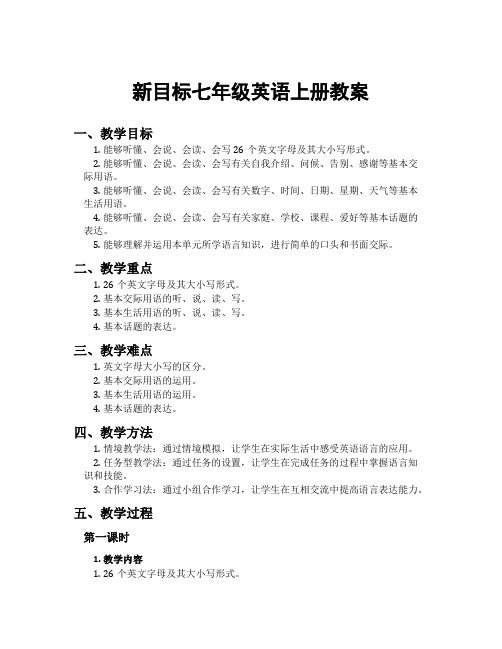
新目标七年级英语上册教案一、教学目标1.能够听懂、会说、会读、会写26个英文字母及其大小写形式。
2.能够听懂、会说、会读、会写有关自我介绍、问候、告别、感谢等基本交际用语。
3.能够听懂、会说、会读、会写有关数字、时间、日期、星期、天气等基本生活用语。
4.能够听懂、会说、会读、会写有关家庭、学校、课程、爱好等基本话题的表达。
5.能够理解并运用本单元所学语言知识,进行简单的口头和书面交际。
二、教学重点1.26个英文字母及其大小写形式。
2.基本交际用语的听、说、读、写。
3.基本生活用语的听、说、读、写。
4.基本话题的表达。
三、教学难点1.英文字母大小写的区分。
2.基本交际用语的运用。
3.基本生活用语的运用。
4.基本话题的表达。
四、教学方法1.情境教学法:通过情境模拟,让学生在实际生活中感受英语语言的应用。
2.任务型教学法:通过任务的设置,让学生在完成任务的过程中掌握语言知识和技能。
3.合作学习法:通过小组合作学习,让学生在互相交流中提高语言表达能力。
五、教学过程第一课时1. 教学内容1.26个英文字母及其大小写形式。
2.字母的发音。
2. 教学目标1.能够听懂、会说、会读、会写26个英文字母及其大小写形式。
2.能够正确发音26个英文字母。
3. 教学重点1.26个英文字母及其大小写形式。
2.字母的发音。
4. 教学难点1.英文字母大小写的区分。
2.字母的发音。
5. 教学方法1.情境教学法。
2.任务型教学法。
6. 教学过程1.导入新课:通过展示26个英文字母的图片,让学生猜测这些是什么,引出本课的学习内容。
2.学习新知:教师通过展示26个英文字母的图片,让学生认识每个字母的形状和大小写形式,并教授每个字母的发音。
3.合作学习:将学生分成小组,让他们在小组内互相练习字母的发音和大小写形式,并在小组内完成任务:用26个英文字母拼出自己的名字。
4.拓展练习:让学生在课后完成练习册上的相关练习。
第二课时1. 教学内容1.自我介绍。
新目标英语七年级上册教案优秀6篇

新目标英语七年级上册教案优秀6篇新目标英语七班级上册教案(精选篇1)教学内容Section A(教材P25—27)教学目标学问与力量Section A的主要内容是学会用have对物品的所属进行提问以及应答,学会使用do和does引导的一般疑问句,学会用Let’s…提建议。
能够谈论自己喜爱哪些球类运动,不喜爱哪些球类运动。
过程与方法采纳Discussion and guess和Classifying的学习策略,利用实物、教学幻灯片、图片等来绽开课堂Pair work 问答式的口语交际活动,使用have对物品的所属进行提问及回答。
情感态度价值观该部分学习内容贴近同学的生活,谈论的主题是符合同学宠爱运动的心理,极易于激发同学学习英语的欲望和爱好,使他们乐于参加各种英语实践活动。
教学重、难点及教学突破重点学习运用重点句型Do you/they have… ? Does he/she have…? Let’s play soccer.等;语法难点行为动词have的一般现在时的用法;使用do和does引导的一般疑问句的构成和使用。
教学突破Section A重在通过使用动词have对物品的所属进行提问和回答的沟通式口语活动,学习由助动词do或does引导的一般疑问句的构成以及回答。
老师要擅长引导同学比较行为动词的疑问句和be动词的疑问句在构成和回答上的区分,通过大量和反复地操练以达到运用自如教学预备老师预备收集课文中所涉及的或同学常见的球类运动器材或有关的教学幻灯片或图片;设计课后巩固练习的幻灯片;制作1a部分的插图和人物对话的课件,将听力部分的内容插人,通过询问对方的所属以及回答来引入新课。
同学预备搜集自己所了解的或曾经见过的球类运动器材的名称,并通过询问老师、同学或上网查询的方式了解各种运动的竞赛方法。
(1课时)一、第一教学环节:情景创设,导入新课老师活动同学活动Section A主要内容是通过使用have对物品的所属进行提问和应答,来学会使用do和does引导的一般疑问句。
新目标英语七年级上教案

新目标英语七年级上教案教案标题:新目标英语七年级上教案教案目标:1. 通过本教案的学习,学生将能够掌握英语七年级上册的基本词汇、语法和句型。
2. 培养学生的英语听、说、读、写的基本能力,提高他们的英语交际能力。
3. 培养学生的学习策略和自主学习能力,激发他们的学习兴趣和自信心。
教学重点:1. 学习并掌握七年级上册的词汇和基本句型。
2. 提高学生的听力和口语表达能力。
3. 培养学生的学习策略和自主学习能力。
教学难点:1. 培养学生的学习策略和自主学习能力。
2. 提高学生的口语表达能力。
教学准备:1. 教师准备教材《新目标英语七年级上册》、多媒体课件、录音设备等。
2. 学生准备教材、笔记本、词典等。
教学过程:一、导入(5分钟)1. 利用多媒体课件播放一段与本课内容相关的视频或音频,引起学生的兴趣和注意。
2. 通过提问或展示图片,引导学生回忆和复习上节课学习的内容。
二、新课呈现(15分钟)1. 教师通过多媒体课件呈现本课的新词汇,并给出中文解释和示例句。
2. 教师通过多媒体课件呈现本课的语法和句型,并给出相应的例句和练习。
三、听说训练(20分钟)1. 教师播放录音材料,让学生跟读并模仿语音语调。
2. 教师组织学生进行对话练习,通过角色扮演等方式进行口语训练。
四、阅读训练(15分钟)1. 教师组织学生进行课文阅读,帮助他们理解课文内容。
2. 教师设计相关的阅读理解题目,让学生进行阅读训练和答题。
五、写作训练(15分钟)1. 教师设计写作任务,让学生运用所学知识写一篇短文或对话。
2. 教师提供写作指导和反馈,帮助学生提高写作能力。
六、课堂练习(10分钟)1. 教师设计一些小练习,让学生巩固所学知识。
2. 教师检查学生的练习情况,及时给予反馈和指导。
七、作业布置(5分钟)1. 教师布置适量的作业,巩固所学知识。
2. 教师解答学生提出的问题,并鼓励他们主动学习和思考。
教学反思:通过本节课的教学,学生对新目标英语七年级上册的词汇、语法和句型有了初步的了解和掌握。
- 1、下载文档前请自行甄别文档内容的完整性,平台不提供额外的编辑、内容补充、找答案等附加服务。
- 2、"仅部分预览"的文档,不可在线预览部分如存在完整性等问题,可反馈申请退款(可完整预览的文档不适用该条件!)。
- 3、如文档侵犯您的权益,请联系客服反馈,我们会尽快为您处理(人工客服工作时间:9:00-18:30)。
(此文档为word格式,下载后您可任意编辑修改!)Starter Unit 1 Good morning!课程目标一、知识和能力目标本单元要求学生掌握英文字母A—H,能认读其印刷体和手写体字母的大小写等四种形式。
书写(大写和小写,笔顺,笔画)基本合乎要求。
能看,听,说本单元所列的日常交际用语,重点学会打招呼,并做到语音语调正确。
注意一些字母及日常交际用语的发音,提醒学生不要将Csi:发成sei:;也不要将Good morning二、过程和方法目标教师要尽量用英语组织教学。
充分利用课堂的40分钟,不讲或少讲汉语,尽量给学生创造英语情景。
教师可以用手势,表情,动作等示意,帮助学生听懂课堂用语和日常交际用语,第一次介绍某个用语时,说英语,加译文及手势,以后可酌情省去译文,最后只说英语,逐步让学生听懂。
三、情感态度和价值观目标万事开头难,首先利用这个单元培养学生们对英语的兴趣,因为兴趣是最好的老师。
学情分析体会打招呼用语的奥妙所在,做到灵活运用。
1.Good morning afternoon evening:适用于比较正式客气的场合,双方都应说Good morning afternoon evening!例如:A:Good morning,Miss Zhao.早晨好,赵老师。
B:Good morning,Mr.Wang.早晨好,王校长。
2.Morning:适用于比较熟悉的朋友之间或比较繁忙的情况下。
3.Hello:是最广泛、最简单的打招呼语,显得亲切自然。
例如:A:Hello,Kate.你好,凯特。
B:Hero,Li Lei.你好,李雷。
4.Hi:在现代英语中,Hi比Hello用得更多,显得更随和。
例如:A:Hi,Han Meimei.你好,韩梅梅。
B:Hi,Lucy.你好,露西。
教学准备tape—recorder,multimedium.课时参考四课时Period 1Step 1:IntroductionBegin by greeting the class with a smile and good morning!Now,introduce the words “teacher” and “class”.by using gestures.Repeatthis several times and answer as a whole group.As rows and as individuals.Repeat “I am your teacher and you are the class” several times.Now,introduce the class to the instructions:Class,please sit down and class,please stand up by using actions and gestures.They can practice this several times.Step 2:Lead—inYou may want t0 leave the class again to introduce the usual Good morning routine.Say Good morning class.Help students respond with Good morning.Point to yourself and say I’m Miss,Mr.…Have them repeat.Explain the terms Miss and Mr.in Chinese.Repeat this a few times with rows and individuals or try a “back-chain” drill:Miss,Mr.… (Ss repeat)Morning,MissM r.… (S s repeat)Good morning,Miss,Mr.… (Ss repeat)Step 3:PracticeSay:Stand up,please! (Ss stand up)Leave the classroom,return and say Good morning,class! Help the students respond with Good morning,Miss,Mr.…Say Sit down,please.No w let’s sta rt the lesson.Step 4:Presentation and activityNow point to yourself and say My name is MissMr. … I am your teacher.Find a student you know and say your name is…(Beth).Then ask What is your name? Help them respond with My name is… . When the student answers, respond with Hel lo…Nice to meet you! Repeat this activity several times,first with students you know and then with others.Help them to respond with Nice to meet you,too.Explain the Word “too’’ in Chinese.Step 5:PracticeGet the students to practice the f0llowing dialogue in pairs.S1:Good morning.S2:Good morning.I’m (Ben).What’s your name?Sl:My name is (Dale).Nice to meet you!S2:Nice to meet you.too.Call out several pairs of students to give their performance.Praise their efforts as much as possible.Help the slower students with patience.Step 6:PresentationDo activity 1a:Look at the picture.Find the small letters for these big letters.First present letters a- the letter Csi:notsei:.H eʧnot eʧStep 7:Listening and writingGet the students to listen to the tape and finish the task list on the book.Make sure all the students know what they should do.Have the students watch the teacher writing the letters on the blackboard, then ask them tofollow the teacher and write down these letters on their exercise—books.Let the students know the diffences between the big letters and the small letters.Step 8:Games timeLet the students do some letters games to enjoy your lesson,the following is the instruction.抢读字母游戏:教师将全班分成若干小组,然后逐个出示字母卡片,学生们举手抢答。
教师让最先举手的学生读出该字母,读对的给该组记lO分,得分最多的组为优胜组。
Step 9: HomeworkCopy the conversation and letters. (Do entering famous school)Period 2Step 1:Lead—inDo free talk:Greet students and ask them to greet each other. Play a role game. Ask students to collect information about their idols such as Bill Gates, Thomas Edison, Jacky Cheng and so on and write their names down. Get them act as their idols and introduce themselves to their partners. The following is sample:T: Good morning, My name is Bill Gates.S: Good morning, I’m Jacky Cheng.T: Nice to meet you, Jacky.S: Nice to meet you, too. Bill.Encourage the students to care what kind of English they can find in the street or in the other ways. Show the students some CDs and ask them if they know what it is. Repeat with the other things. And add some more things such as DVD and KFC. Train the students to care the things card. OK means all right. Then get them to finish the exercise on the screen. Go on doing the above step to ask them to list more about the abbreviation. (See the powerpoint)Step 2:PairworkLet students work in pairs to practice the dialogue on 3a.Get them to act it out after practicing. Do 3b.Make sure all the students know the answers correctly. Let the students try their best to remember chorus and individual. Give them a chance to perform.Praise their efforts as much as possible.Help the slower students with patience.Step 4:HomeworkCopy the letters and the new words and finish off the workbook. (Do entering famous school)Period 3Step 1: Lead-inBegin the class with singing the song of “Good morning” together. Free talk. Ask : Hi! Good morning, Tom. Or Morning, Dale. etc. Let the students get used to speaking English in class,even after class, Encourage the students to speak English as much as possible.Say out all the letters in English while you are pointing the letters or things in the classroom.Make sure all the students know what you are saying and what it is in English.Speech Cassette la of section B.Play the tape and ask the students to listen to it carefully, then act it out, also do the task of lb on the book.Next get the students to write down the small lettersfor each word (abbr.).Step 2:PairworkGet the students to practise the dialogue by pointing out the things they know English.Ask the students to exchange the roles.Let them fill in the missing letter of each word in pairs.Step 3:Listen and repeatList out the letter A on the blackboard and encourage the students to say out what other words a1so make the same pronunciation.Give them some tips. Present the other letters the same as the 1etter A.Let the students follow the chant after the tape.Step 4:HomeworkFinish off the workbook.(Do entering famous school)Period 4Step 1:Go through all the contents list on this part,make sure all the students understand them.If they don’t,you may use Chinese to explain it. (Do entering famous school)单元教学测评一、写出下列字母左邻右舍1. _____B______2. ______c ______3. _____f______4. ____E_____5. _____g _____二、写出下列大字字母的小写字母。
